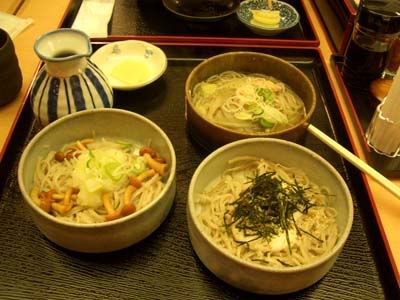SundayWith a bit of free time just after lunch on Sunday, I decided to make a trip down to the two major temples located at just a 5 minutes walk from my apartment. The first temple is the one seen in the picture below. I passed by it daily while going to work and coming back as it is along the main road. While in it, I noticed it is quite empty with a large compound in front of the main hall. The architecture is quite a good blend of Chinese and Japanese design. The temple is of the Pure Land school of Buddhism; their emphasis being on the practice of Amitabha Buddha. There are scores of families making visit to the cemetary which is just behind the temple. After spending around 10 minutes walking through the temple grounds, I make my way to the next temple. 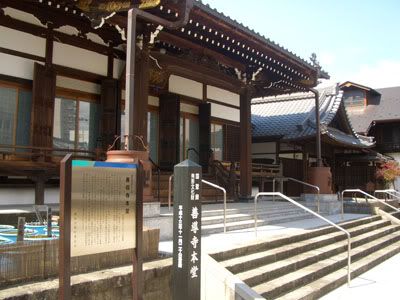 The second temple is the largest one in the city of Koriyama. A number of the temple properties have been labelled as the state's treasures. There are actually two entrances to the temple, with a large garden in between them. The picture shown below is the entrance to the right and the garden is just next to it. The entrance to the left is guarded by the local gods of God of Thunder and the God of Wind. They are large and quite fierce looking if you were to look straight into their eyes.This temple belongs to the school of Shingon; it is quite similar to Tibetan tantric Buddhism, which explains the presence of the local protector gods. For more information on these different schools of Buddhism, can search through Wikipedia or just ask me about it.
The second temple is the largest one in the city of Koriyama. A number of the temple properties have been labelled as the state's treasures. There are actually two entrances to the temple, with a large garden in between them. The picture shown below is the entrance to the right and the garden is just next to it. The entrance to the left is guarded by the local gods of God of Thunder and the God of Wind. They are large and quite fierce looking if you were to look straight into their eyes.This temple belongs to the school of Shingon; it is quite similar to Tibetan tantric Buddhism, which explains the presence of the local protector gods. For more information on these different schools of Buddhism, can search through Wikipedia or just ask me about it.
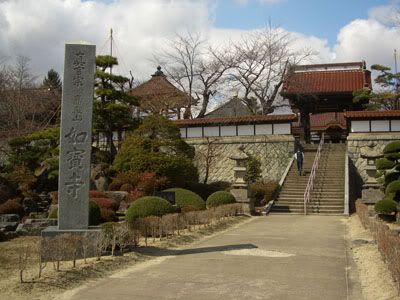 This temple compound is actually much larger than the previous one. There are more people here with cars being parked along the quadrangle. The picture below shows the main shrine of the temple. Surrounding it is the library, the shrine of Kannon (Guan Yin in Chinese, Avalokiteshvara in Sanskirt, Chenrezig in Tibetan), the Bodhisattva of Great Compassion. Behind this temple is also another cemetary, so they are many people making visit to it. I noticed there are people entering the main shrine of the temple, so I decided to just follow along and check out what is in there. The design of the main shrine is quite typically Japanese. People entering the main hall all make their way to the sides which is where their ancestors tablets are housed. I went in along and pay my respect to the deceased. On my way out, I made a donation to the temple and received a 'Siddham'. This is one unique aspect of Shingon Buddhism in that of the incorporation of calligraphy into their practices. The 'Siddham' is actually a wooden board with a mantra written on it. For me, I will be keeping it as a souvenir.
This temple compound is actually much larger than the previous one. There are more people here with cars being parked along the quadrangle. The picture below shows the main shrine of the temple. Surrounding it is the library, the shrine of Kannon (Guan Yin in Chinese, Avalokiteshvara in Sanskirt, Chenrezig in Tibetan), the Bodhisattva of Great Compassion. Behind this temple is also another cemetary, so they are many people making visit to it. I noticed there are people entering the main shrine of the temple, so I decided to just follow along and check out what is in there. The design of the main shrine is quite typically Japanese. People entering the main hall all make their way to the sides which is where their ancestors tablets are housed. I went in along and pay my respect to the deceased. On my way out, I made a donation to the temple and received a 'Siddham'. This is one unique aspect of Shingon Buddhism in that of the incorporation of calligraphy into their practices. The 'Siddham' is actually a wooden board with a mantra written on it. For me, I will be keeping it as a souvenir.  As I was busy much of the weekdays, so there are no updates.SaturdayThe trip for today will be to the city of Sendai, the largest city to the north of Tokyo. I woke up the same time as it is last saturday and met up with the rest before making our way down to the Bus Station. I had enquired the bus timings and cost the night before at the bus station so we can time ourselves perfectly to the departure of the bus. The bus journey is around 2 hours long before our arrival at Sendai Station. The city of Sendai is indeed many times larger than Koriyama. Skyscrapers is quite a norm in the city, with the famous Tohoku University located in the city, Sendai is indeed quite a city with life. We alighted from the bus and made our way to the Sendai Bus Station as seen below. It is quite a large imposing structure.
As I was busy much of the weekdays, so there are no updates.SaturdayThe trip for today will be to the city of Sendai, the largest city to the north of Tokyo. I woke up the same time as it is last saturday and met up with the rest before making our way down to the Bus Station. I had enquired the bus timings and cost the night before at the bus station so we can time ourselves perfectly to the departure of the bus. The bus journey is around 2 hours long before our arrival at Sendai Station. The city of Sendai is indeed many times larger than Koriyama. Skyscrapers is quite a norm in the city, with the famous Tohoku University located in the city, Sendai is indeed quite a city with life. We alighted from the bus and made our way to the Sendai Bus Station as seen below. It is quite a large imposing structure.
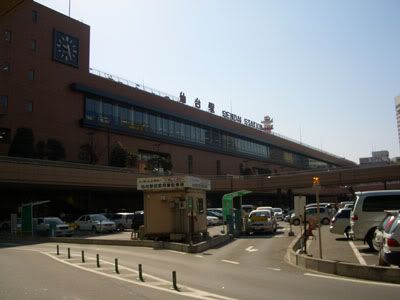 Something unique which I find about the Sendai station is that all its station operations are at the second level. The first level is more like a car park and bus station. Right in front of the second level station is a large levelled compound linked to the various junctions via highly accessible bridges.
Something unique which I find about the Sendai station is that all its station operations are at the second level. The first level is more like a car park and bus station. Right in front of the second level station is a large levelled compound linked to the various junctions via highly accessible bridges.  We went in to inquire about the sights of Sendai city and were recommended two stops: The Masamune Date's mausoleum and the park where the remains of Sendai castle are. Masamune Date is a great lord of Sendai that lived during the warring era of Japan. He is highly regarded for his feats and his entrepreneur spirit on how he manages politics, economics and military matters. We hopped on the City Bus and went on to our first stop.The entrance to the mausoleum is shown below:
We went in to inquire about the sights of Sendai city and were recommended two stops: The Masamune Date's mausoleum and the park where the remains of Sendai castle are. Masamune Date is a great lord of Sendai that lived during the warring era of Japan. He is highly regarded for his feats and his entrepreneur spirit on how he manages politics, economics and military matters. We hopped on the City Bus and went on to our first stop.The entrance to the mausoleum is shown below: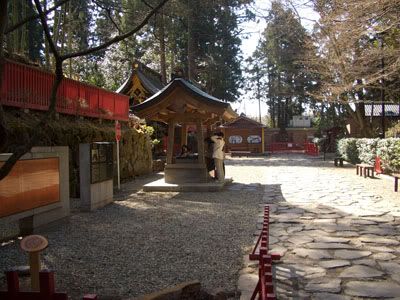 The buildings likewise are all traditionally Japanese shaped. If you all noticed the door behind the big entrance below, it is actually a blend of both traditional Japanese and modern technology. It is an automatic wooden door. When visitors approach it, it will open automatically. Quite a style...
The buildings likewise are all traditionally Japanese shaped. If you all noticed the door behind the big entrance below, it is actually a blend of both traditional Japanese and modern technology. It is an automatic wooden door. When visitors approach it, it will open automatically. Quite a style...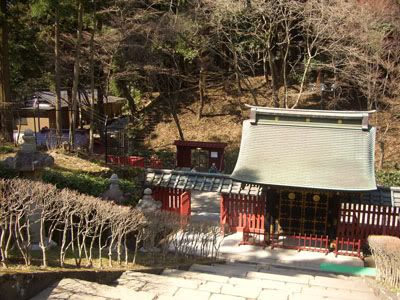 Masamune Date's mausoleum is seen below. His son and grandson mausoleum is opposite at another hill. The design is quite grand with a museum next to it describing how the excavation process was conducted by the Japanese archaeologists.
Masamune Date's mausoleum is seen below. His son and grandson mausoleum is opposite at another hill. The design is quite grand with a museum next to it describing how the excavation process was conducted by the Japanese archaeologists.  After visiting the mausoleum, we went on to the temple somewhere down the temple grounds. There is no one in there. I took a quite photo shot of the heart sutra written on a stone block.
After visiting the mausoleum, we went on to the temple somewhere down the temple grounds. There is no one in there. I took a quite photo shot of the heart sutra written on a stone block.
 We hopped onto the City Bus again to the next stop, the remains of Sendai Castle.
We hopped onto the City Bus again to the next stop, the remains of Sendai Castle. At the top of the hill where Sendai Castle was previously located, we noticed a large statue of Kannon in the distance. Wonder where it is...
At the top of the hill where Sendai Castle was previously located, we noticed a large statue of Kannon in the distance. Wonder where it is... Here is the statue of Masamune Date in his military armour. He is distinctively recognised by his crescent moon helmet.
Here is the statue of Masamune Date in his military armour. He is distinctively recognised by his crescent moon helmet.
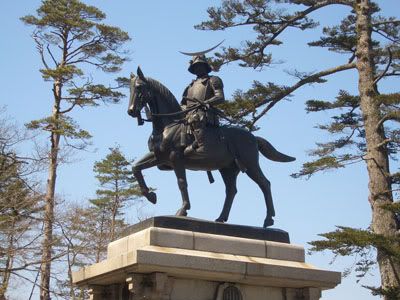 We visited a temple next to the remains ground. It is quite Shinto in origin but the building design is extremely new as compared to the many I have visited.
We visited a temple next to the remains ground. It is quite Shinto in origin but the building design is extremely new as compared to the many I have visited.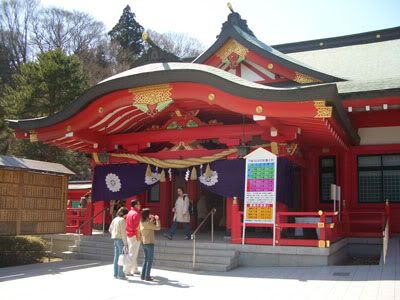 There is a doll performance going on in one of the machines, so I took a short video clip of it below.
There is a doll performance going on in one of the machines, so I took a short video clip of it below.
My local guide mentioned that this temple actually commerate the war dead of a Japanese battleship. That explains the constant military music resonating from one of the buildings and a Japanese flag flapping in the winds. This temple looks quite new and commercialise anyway, with many amulet stores lining along the way.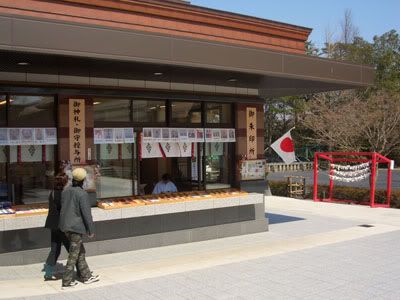 Thereafter we went back to Sendai City centre. I came upon a Japanese monk by the side of the Station's bridge. So I made a small donation to him and in response, he ringed his staff.
Thereafter we went back to Sendai City centre. I came upon a Japanese monk by the side of the Station's bridge. So I made a small donation to him and in response, he ringed his staff. 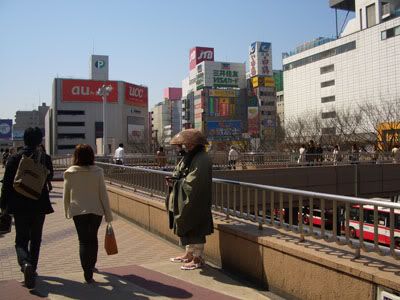 We are back at the station and we have to give the local famous specialty a try, it is Gyutan, also known as Cow's Tongue. There are many stores selling Gyutan and we had to queue up at one before going in.
We are back at the station and we have to give the local famous specialty a try, it is Gyutan, also known as Cow's Tongue. There are many stores selling Gyutan and we had to queue up at one before going in.
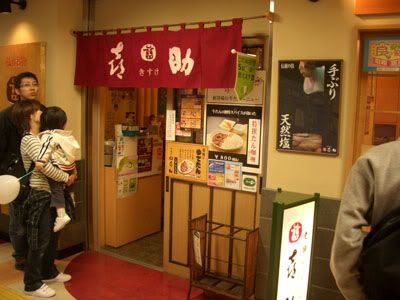 Here is a photo of the chef preparing the Gyutan. His movements are fast and I noticed his hands are burning red from the BBQ.
Here is a photo of the chef preparing the Gyutan. His movements are fast and I noticed his hands are burning red from the BBQ.
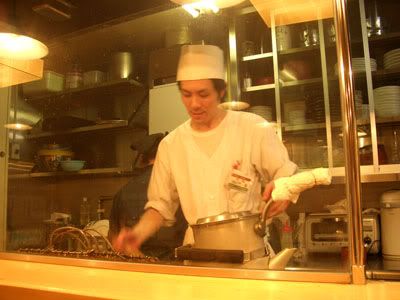 Here is how the Gyutan looks like in three different flavours.
Here is how the Gyutan looks like in three different flavours.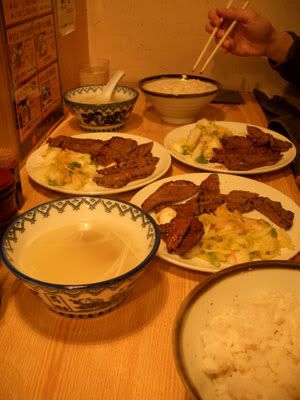 After lunch, we decided to explore one of the top three vacation sights in Japan which is at Matsushima. We travelled to Shiogama station by Densha and will be taking a ferry from there round the islands of Matsushima bay into the seaside town itself.
After lunch, we decided to explore one of the top three vacation sights in Japan which is at Matsushima. We travelled to Shiogama station by Densha and will be taking a ferry from there round the islands of Matsushima bay into the seaside town itself.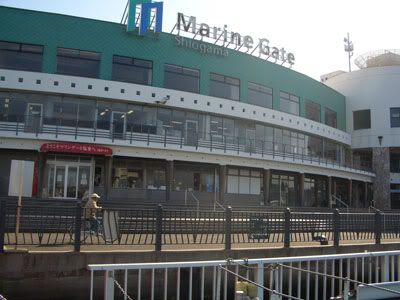 Here is the ferry which we will be on for the next one hour.
Here is the ferry which we will be on for the next one hour.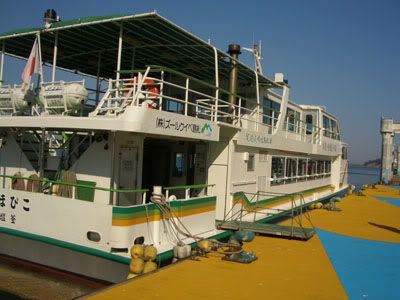 As the ferry moves, the sea gulls follow us along. The passengers are throwing Calibe prawn crackers to them, so they are all flying along for it.
As the ferry moves, the sea gulls follow us along. The passengers are throwing Calibe prawn crackers to them, so they are all flying along for it.
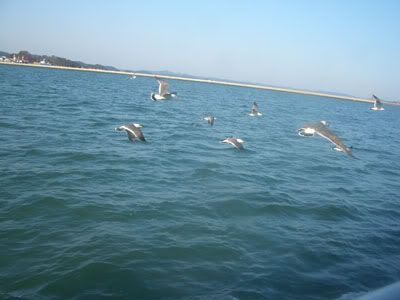 Here is the sight of the sea from the ferry.
Here is the sight of the sea from the ferry. 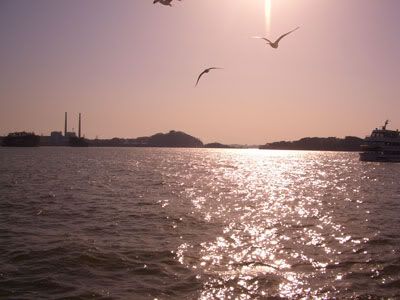 And finally we arrived at Matsushima ferry. Just a 5 minutes walk from the ferry is a temple. It is one of the top recommended sights in Matsushima. I am quite drawn to this wooded path that leads from the temple grounds. It gives an especially serene and peaceful feel when walking through it.
And finally we arrived at Matsushima ferry. Just a 5 minutes walk from the ferry is a temple. It is one of the top recommended sights in Matsushima. I am quite drawn to this wooded path that leads from the temple grounds. It gives an especially serene and peaceful feel when walking through it. 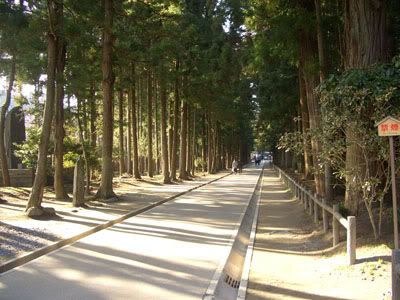 We took another path which passes by the stone encave of the temple. There are possibly 33 statues of Kannon which is donated by the various temples all over Japan.
We took another path which passes by the stone encave of the temple. There are possibly 33 statues of Kannon which is donated by the various temples all over Japan.
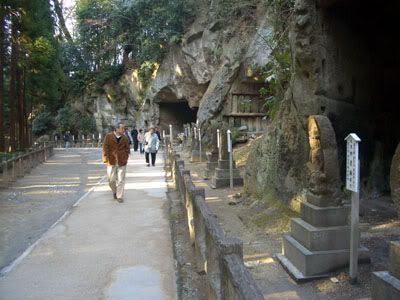 There is also this casual posture of Kannon at the entrance to the main shrine. Water is constantly flowing out of its jar.
There is also this casual posture of Kannon at the entrance to the main shrine. Water is constantly flowing out of its jar. This temple is a Zen temple. Thus the temple grounds and its surroundings are all shaped in a Zen design. The stone pebbles, the evergreen bonsai trees, the simple layout and surroundings.
This temple is a Zen temple. Thus the temple grounds and its surroundings are all shaped in a Zen design. The stone pebbles, the evergreen bonsai trees, the simple layout and surroundings.
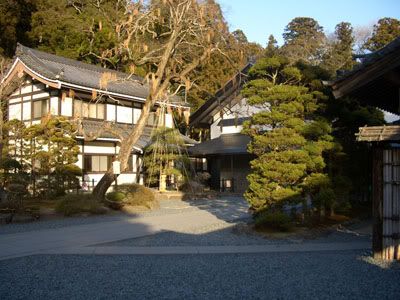 We visited a retreat house at an island some 5 minutes walk from the temple. It feels very peaceful and tranquil indeed.
We visited a retreat house at an island some 5 minutes walk from the temple. It feels very peaceful and tranquil indeed.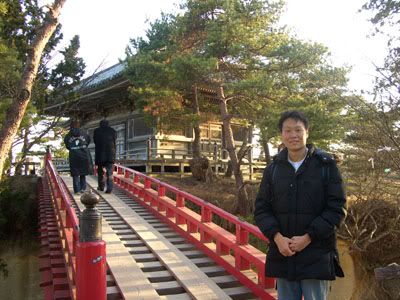 Then we are off and on the way back to Sendai. Along the way, we sampled some of Matsushima's famous bbq oysters. Yummy...
Then we are off and on the way back to Sendai. Along the way, we sampled some of Matsushima's famous bbq oysters. Yummy...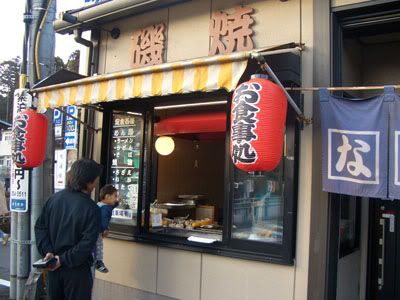 And finally back to the city lights of Sendai city.
And finally back to the city lights of Sendai city.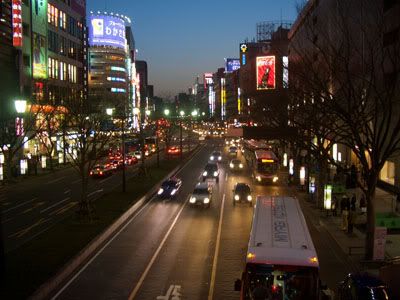 Sendai is a great place for shopping, like the one shown in the picture below. From one end to another end of the mall takes 20 minutes non-stop walking.
Sendai is a great place for shopping, like the one shown in the picture below. From one end to another end of the mall takes 20 minutes non-stop walking.
SundayThe first day of the week is started with me packing up my hotel room and moving to the apartment. The apartment is a 15 minutes walk from my hotel. This time, I choosed a different route, one that doesn't require me to haul the 25kg bag up a stairway and down another. Once I got to the new apartment, I went in to see the estate agent at Leo Palace which is just at the first floor of the new block. She passed me the keys as well as some information on setting up the internet.I went up to the 7th floor and managed to locate the unit quite easily. There are only 5 other people staying on the same floor as me and mine is a corner unit. The unique aspect of this apartment is that it is the most technologically-advanced and I may be one of the first to move into it. There are security camera at the entrance which allow me to monitor visitors looking for me. Thereafter, I will grant them access into the block. Secondly, the key design is unique. It is a key tag, one that looks like a normal ID dog tag but it is used for opening doors. And here I go, I slot in the key and open up the chambers of secret. Viola!!! Here are the scenes that greeted me. A sneak peek into my new apartment. The view of my room when I enter. The view of my room from my balcony.
The view of my room from my balcony.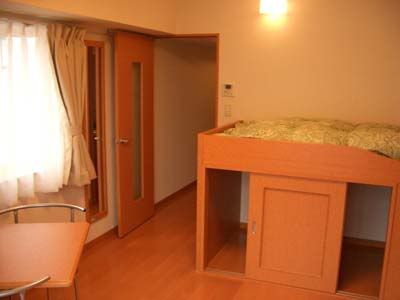 My mini-kitchen
My mini-kitchen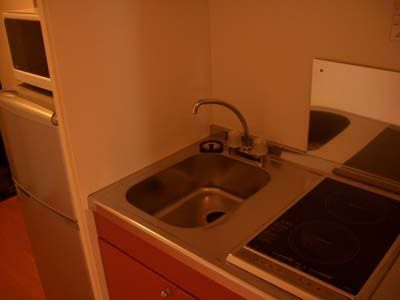 The bathing facilities
The bathing facilities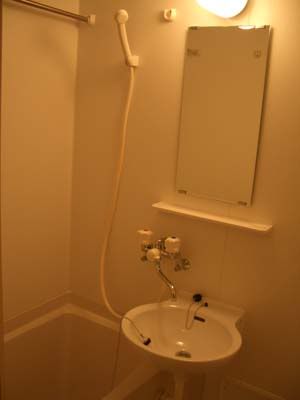 I will not show the toilet as it is just plain and simple. And finally a table for me to put my laptop, work related stuff and still have place to study. This is what I essentially want. I got put off by the hotel room because they are awfully small for me to do anything except to sleep in it.
I will not show the toilet as it is just plain and simple. And finally a table for me to put my laptop, work related stuff and still have place to study. This is what I essentially want. I got put off by the hotel room because they are awfully small for me to do anything except to sleep in it. 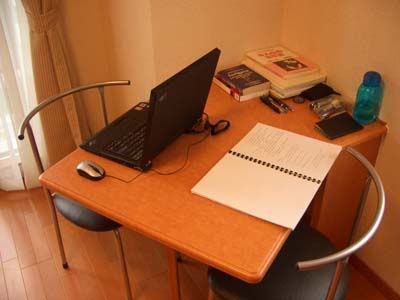 A view of the train station and bus station from my room which is just a 5 minutes walk away. It is the building in the middle. This is the scene which I will be looking at every morning first thing first when I wake up and while I'm having my morning breakfast.
A view of the train station and bus station from my room which is just a 5 minutes walk away. It is the building in the middle. This is the scene which I will be looking at every morning first thing first when I wake up and while I'm having my morning breakfast. 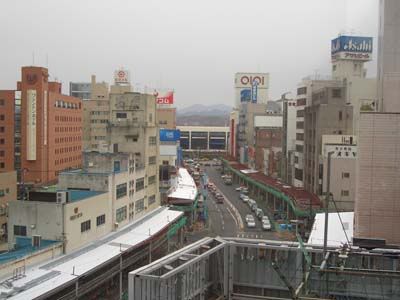 Thereafter the rest of the day is spent visiting my friends and checking out what do they have in their kitchen. The afternoon is running round the city and gathering all the kitchen necessarities. Unfortunately, it started raining in the afternoon so I have to just stay over at my friends' place for a few hours. In the evening, snow flakes started fizzling down the sky. I guess the rain must have plunge the city temperature greatly. Just yesterday, the sun was up and it was 16 degrees celsius. And a day after in the evening, it started snowing. Here are all the stuff I have bought.
Thereafter the rest of the day is spent visiting my friends and checking out what do they have in their kitchen. The afternoon is running round the city and gathering all the kitchen necessarities. Unfortunately, it started raining in the afternoon so I have to just stay over at my friends' place for a few hours. In the evening, snow flakes started fizzling down the sky. I guess the rain must have plunge the city temperature greatly. Just yesterday, the sun was up and it was 16 degrees celsius. And a day after in the evening, it started snowing. Here are all the stuff I have bought. 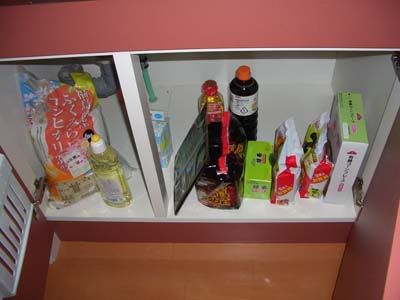 I got back home and started preparing my first meal. Guess I prepared too much. It is the meal which I always wanted consisting of just miso soup, mixed vegetables and rice. This will be my typical dinner if I were to get down preparing. "Soup + Vegetables + Rice" or "Noodles + Toppings"
I got back home and started preparing my first meal. Guess I prepared too much. It is the meal which I always wanted consisting of just miso soup, mixed vegetables and rice. This will be my typical dinner if I were to get down preparing. "Soup + Vegetables + Rice" or "Noodles + Toppings"  MondayThe next day morning breakfast also see the standard breakfast meal which I will never grow tired of. I need bread and milk for breakfast. So they are below. And some cereals to add a dash of sweetness for the day.
MondayThe next day morning breakfast also see the standard breakfast meal which I will never grow tired of. I need bread and milk for breakfast. So they are below. And some cereals to add a dash of sweetness for the day. The place where I will be taking bus will be different. The bus stop shown below is just a 30 seconds walk away. Previously, I need to walk 5 minutes to the bus station from the hotel.
The place where I will be taking bus will be different. The bus stop shown below is just a 30 seconds walk away. Previously, I need to walk 5 minutes to the bus station from the hotel.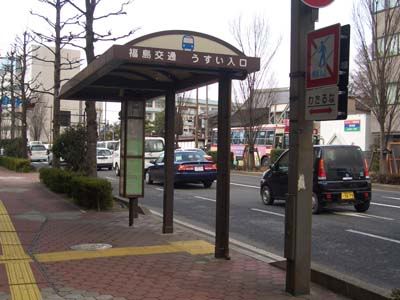 TuesdayWith accumulated snowing on Sunday and Monday, the path leading to the bus stop on Tuesday is covered with patches of snow. I guess this will be the final grasp winter will be having and it will relinquish its cold and give way to spring. This also reminded me the time when I was in Belfast, we were surprised when it started snowing in mid-March. It snowed twice actually and thereafter the temperature warmed and gave way to lovely spring.
TuesdayWith accumulated snowing on Sunday and Monday, the path leading to the bus stop on Tuesday is covered with patches of snow. I guess this will be the final grasp winter will be having and it will relinquish its cold and give way to spring. This also reminded me the time when I was in Belfast, we were surprised when it started snowing in mid-March. It snowed twice actually and thereafter the temperature warmed and gave way to lovely spring.
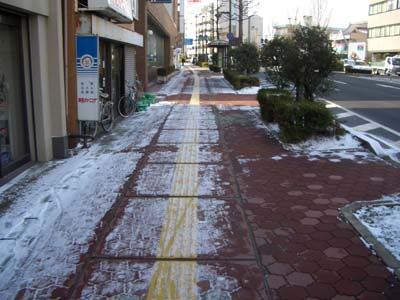 With a fellow friend coming back from Singapore, we had a more exquisite dinner at a traditional Japanese restaurant. Actually I was the one that suggested this place as I am particularly drawn to the fried dishes on display.
With a fellow friend coming back from Singapore, we had a more exquisite dinner at a traditional Japanese restaurant. Actually I was the one that suggested this place as I am particularly drawn to the fried dishes on display.
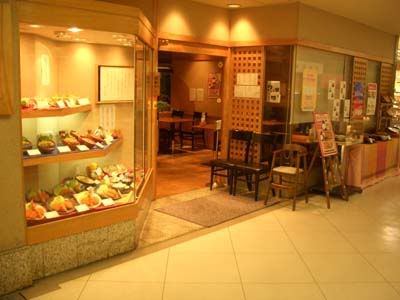 I ordered the largest set meal that is available and it cost around 2000 yen.
I ordered the largest set meal that is available and it cost around 2000 yen.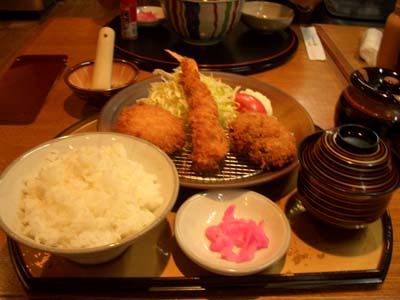 FridayThis is no entry for the last few days as I am quite occupied with work. And finally it is Friday. My friends brought me along to a typical Italian restaurant, Saizeriya. I heard when some of the seniors were in Japan, they visited another branch of this restaurant regularly. They were particularly drawn to the minibar which offers free flow of drinks.
FridayThis is no entry for the last few days as I am quite occupied with work. And finally it is Friday. My friends brought me along to a typical Italian restaurant, Saizeriya. I heard when some of the seniors were in Japan, they visited another branch of this restaurant regularly. They were particularly drawn to the minibar which offers free flow of drinks. 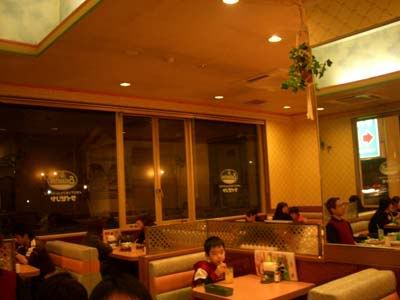 I went for their seafood spaghetti and shared 2 pizzas with those in the same table.
I went for their seafood spaghetti and shared 2 pizzas with those in the same table.  SaturdayThe plan for saturday is to visit a traditional village that is an hour ride from the city of Aizu Wakamatsu. I left my apartment at 7am and met up with the rest. Took an hour bus from Koriyama bus station which cost 1800 yen for the return trip. We alighted at the Aizu Wakamatsu train station. The station is shown below. Just next to it is the statue of the famous White Tigers squad of the 19th century.
SaturdayThe plan for saturday is to visit a traditional village that is an hour ride from the city of Aizu Wakamatsu. I left my apartment at 7am and met up with the rest. Took an hour bus from Koriyama bus station which cost 1800 yen for the return trip. We alighted at the Aizu Wakamatsu train station. The station is shown below. Just next to it is the statue of the famous White Tigers squad of the 19th century. 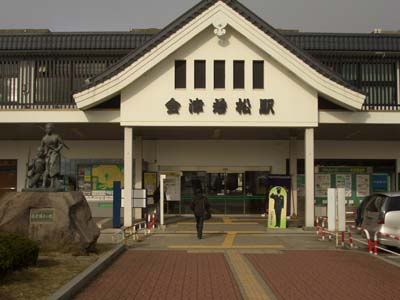 After some inquiry by our local guide, we took the train to Yunokamionsen Station. It is a small 2 carriage train.
After some inquiry by our local guide, we took the train to Yunokamionsen Station. It is a small 2 carriage train.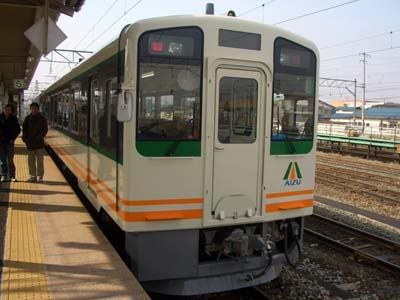 The design of the train interiors are unique. The chairs can be shifted in either direction depending on the moving direction of the train.
The design of the train interiors are unique. The chairs can be shifted in either direction depending on the moving direction of the train.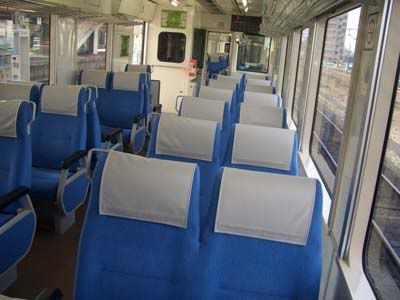 The journey is scheduled to take 40 minutes in all. With the inital journey passing through the local farmlands with the majestic japanese mountains as the backdrop.
The journey is scheduled to take 40 minutes in all. With the inital journey passing through the local farmlands with the majestic japanese mountains as the backdrop.
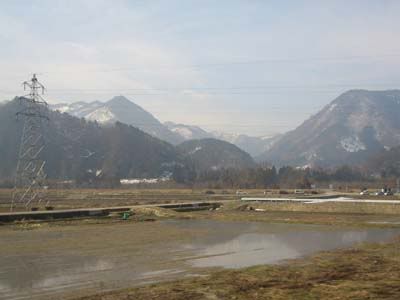 The journey continues deeper into the mountain ranges until much of the area is covered with snow. The mountains started to envelope the train with it passing through multiple tunnels.
The journey continues deeper into the mountain ranges until much of the area is covered with snow. The mountains started to envelope the train with it passing through multiple tunnels.
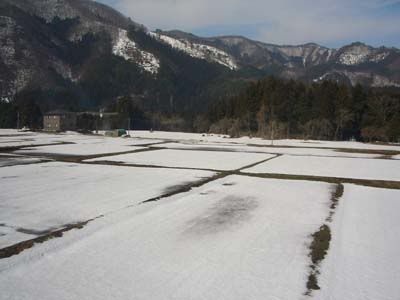 And finally we arrived at Yunokamionsen Station. Yunokami is the name of the place. And onsen means natural hotspring bath. It is an extremely small station and it is made of wood. The first sight that greeted us when we entered the station is this unique heating pot. This is what keeps the whole station warm. We took a few photos of it until we find the smoke drifting out from it to be irritating.
And finally we arrived at Yunokamionsen Station. Yunokami is the name of the place. And onsen means natural hotspring bath. It is an extremely small station and it is made of wood. The first sight that greeted us when we entered the station is this unique heating pot. This is what keeps the whole station warm. We took a few photos of it until we find the smoke drifting out from it to be irritating. 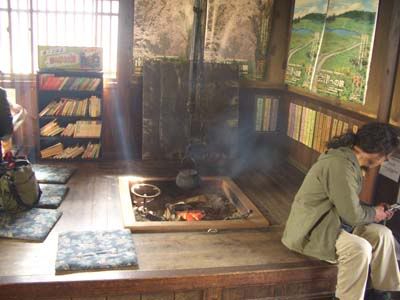 This is the only station in the whole of Japan that is made of traditional wood. It has received an award for being one of the top 100 stations in Japan.
This is the only station in the whole of Japan that is made of traditional wood. It has received an award for being one of the top 100 stations in Japan.
 Thereafter, we have to take a local vehicle from the station to the traditional village. It involves driving through the undulating mountain road.
Thereafter, we have to take a local vehicle from the station to the traditional village. It involves driving through the undulating mountain road.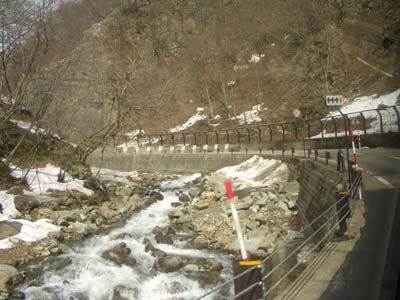 And we have reached our destination at last. The village is just next to a whole field of snow.
And we have reached our destination at last. The village is just next to a whole field of snow.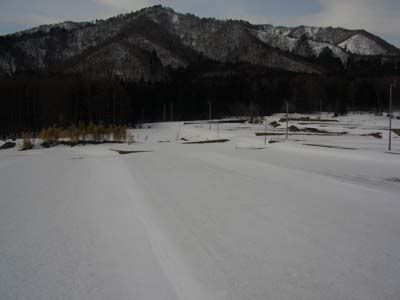 The traditional Japanese village as seen below.
The traditional Japanese village as seen below.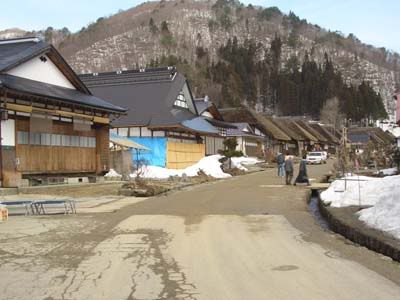 Some of the shops are selling traditional Japanese snacks. We bought a couple of them and sample along the way.
Some of the shops are selling traditional Japanese snacks. We bought a couple of them and sample along the way.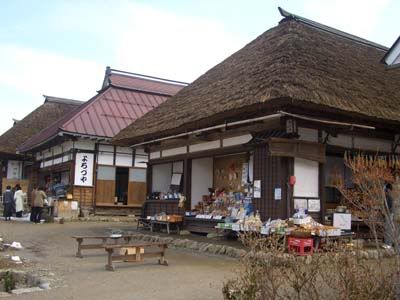 At the end of the village, there is a shrine at the top of the mountain. I climbed up the mountain, with the top getting treacherous as it is ice covered. Getting up was easy but getting down is the difficult part as always.
At the end of the village, there is a shrine at the top of the mountain. I climbed up the mountain, with the top getting treacherous as it is ice covered. Getting up was easy but getting down is the difficult part as always.
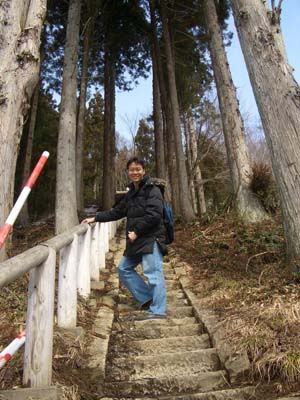 For our lunch, we decided to go traditional also. So we stopped by a soba shop and stayed in for a meal.
For our lunch, we decided to go traditional also. So we stopped by a soba shop and stayed in for a meal.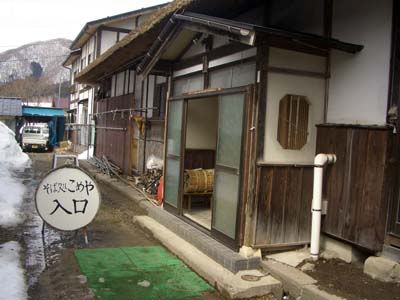 This is how the interiors look like.
This is how the interiors look like. 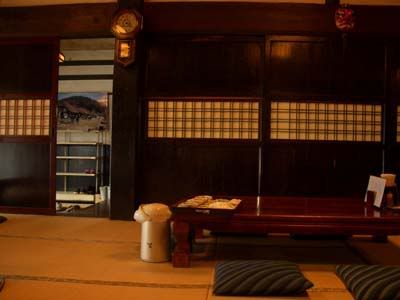 Thereafter we went back to Aizu Wakamatsu and decide to explore the main attraction of the town. This town is the only place that is mentioned in the whole of Fukushima prefecture, with the entire 5 pages devoted entirely to it. We took a tour bus to the various sights.
Thereafter we went back to Aizu Wakamatsu and decide to explore the main attraction of the town. This town is the only place that is mentioned in the whole of Fukushima prefecture, with the entire 5 pages devoted entirely to it. We took a tour bus to the various sights.
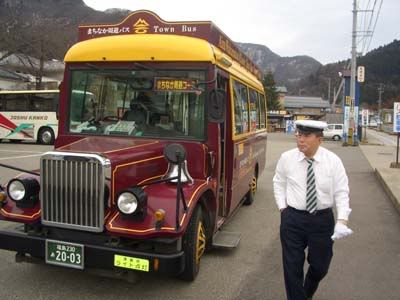 At the first stop is the residence of the chief retainer (Aizu Bukeyashiki) of the lord of this land. The role of the chief retainer is liken to a knight commander of the west. So it is quite luxurious in those days and extremely large which can housed up to hundreds of people. We went in the entrance to their residence.
At the first stop is the residence of the chief retainer (Aizu Bukeyashiki) of the lord of this land. The role of the chief retainer is liken to a knight commander of the west. So it is quite luxurious in those days and extremely large which can housed up to hundreds of people. We went in the entrance to their residence.
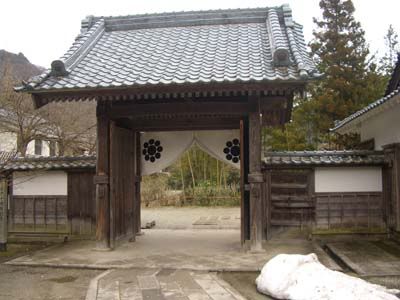 There are mannequins which re-enact the entire household and their style of living. Every part of the residence is on display, ranging from the toilets, kitchens, to their weapon rooms and shrines.
There are mannequins which re-enact the entire household and their style of living. Every part of the residence is on display, ranging from the toilets, kitchens, to their weapon rooms and shrines. 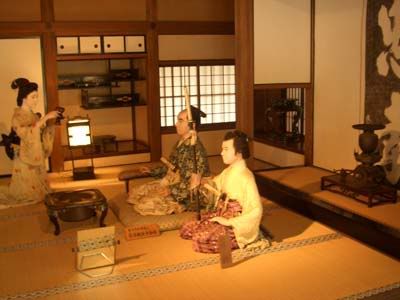 At the centre of the residence is a statue of a Chinese monk who was invited to Japan in the 8th century. His name is Ganjin. It took him 5 attempts and 12 years to finally reached Japan. He spread the main Vinaya rules to Japan and was bestowed the honor of "Daiwajyo" from the Japanese government. Since then he has been called a symbol of friendship between China and Japan.
At the centre of the residence is a statue of a Chinese monk who was invited to Japan in the 8th century. His name is Ganjin. It took him 5 attempts and 12 years to finally reached Japan. He spread the main Vinaya rules to Japan and was bestowed the honor of "Daiwajyo" from the Japanese government. Since then he has been called a symbol of friendship between China and Japan.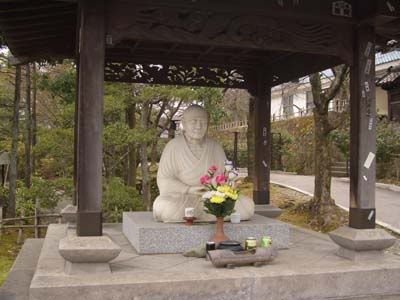 There were a few shrines to the east of the residence. One of it is devoted to the God of Study. Blessing and amulets can be found next to these shrines. It look like the one below:
There were a few shrines to the east of the residence. One of it is devoted to the God of Study. Blessing and amulets can be found next to these shrines. It look like the one below: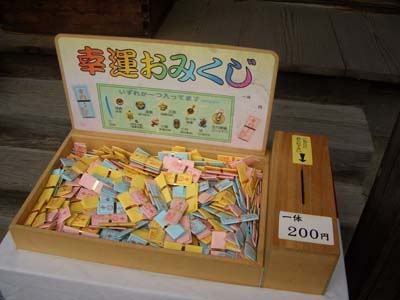 Once we have finished the Chief Retainer's Residence, we went on to the next stop which is the White Tigers museum. It is the main attraction and highlight of this town.
Once we have finished the Chief Retainer's Residence, we went on to the next stop which is the White Tigers museum. It is the main attraction and highlight of this town.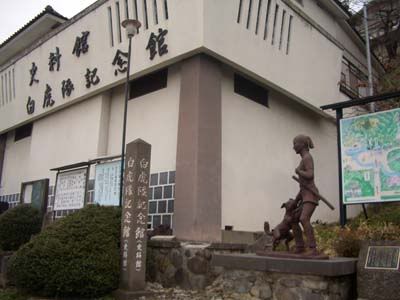 No photos were allowed in the museum. But here is the story of the White Tigers Squad (Byakkotai):At the top of this hill are the graves of 19 boys, members of the Byakkotai who committed suicide at this place in 1868. They were part of a larger group of forty boys between the ages of 15 and 17 who were ordered into battle against the Meiji government soldiers by the last of the Aizu clan daimyo, Katamori Matsudaira.
No photos were allowed in the museum. But here is the story of the White Tigers Squad (Byakkotai):At the top of this hill are the graves of 19 boys, members of the Byakkotai who committed suicide at this place in 1868. They were part of a larger group of forty boys between the ages of 15 and 17 who were ordered into battle against the Meiji government soldiers by the last of the Aizu clan daimyo, Katamori Matsudaira.
The boys, in their first battle, were defeated and 20 survivors retreated to Iimoriyama Hill. When they got there, exhausted and hungry, to their utter dismay they saw smoke and fires around Tsurugajo Castle below them in the distance. Fearing that the castle had been sacked by their enemies and that all was lost, they decided to commit ritual suicide by hara-kiri (slicing their stomachs open) according to the samurai code.
In fact, at that time, the castle was not on fire making the Byakkotai incident even more tragic. The castle surroundings were on fire instead. But eventually, the castle was surrendered a month later.
One boy, Sadakichi Iinuma, was rescured and had survived. He kept numb to the entirely incident until 50 years later. He was eventually buried close to his comrades when he passed away. All the tombstones in the cemetary are facing towards the castle. Below is the photo of the local guide detailing the story of the Byakkotai.  The view from the top of the Iimoriyama where the boys have seen the castle on fire.
The view from the top of the Iimoriyama where the boys have seen the castle on fire.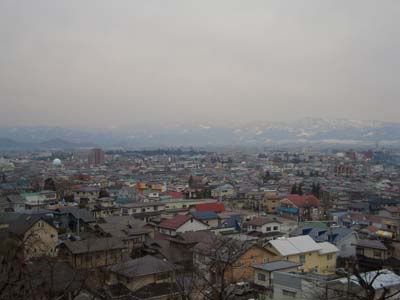 Down the cemetary hill from the side is the Sazae-do. It is a 18th century hexagonal hall (pagoda) which contains the statues of Kannon (Guan Yin). It has a fabulous spiral staircase that allows you to walk up and down without retracing your steps.
Down the cemetary hill from the side is the Sazae-do. It is a 18th century hexagonal hall (pagoda) which contains the statues of Kannon (Guan Yin). It has a fabulous spiral staircase that allows you to walk up and down without retracing your steps.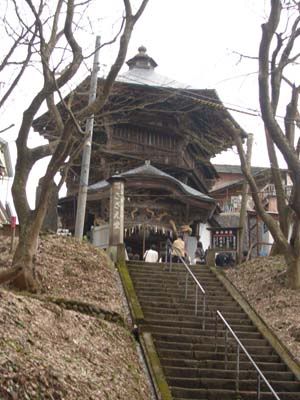 And finally we are back to the Aizu train station. We noticed the chef is preparing noodles at one of the restaurant and decided to give it a try.
And finally we are back to the Aizu train station. We noticed the chef is preparing noodles at one of the restaurant and decided to give it a try.
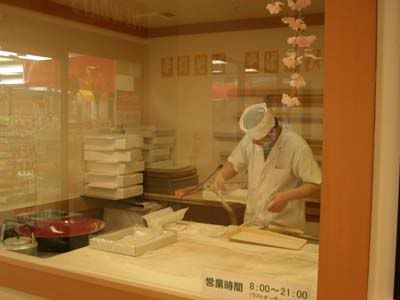 The restaurant is quite a mix of traditional and modern feel.
The restaurant is quite a mix of traditional and modern feel. I ordered a 3-favoured dishes menu. 3 sobas prepared differently and presented for the variety.
I ordered a 3-favoured dishes menu. 3 sobas prepared differently and presented for the variety.